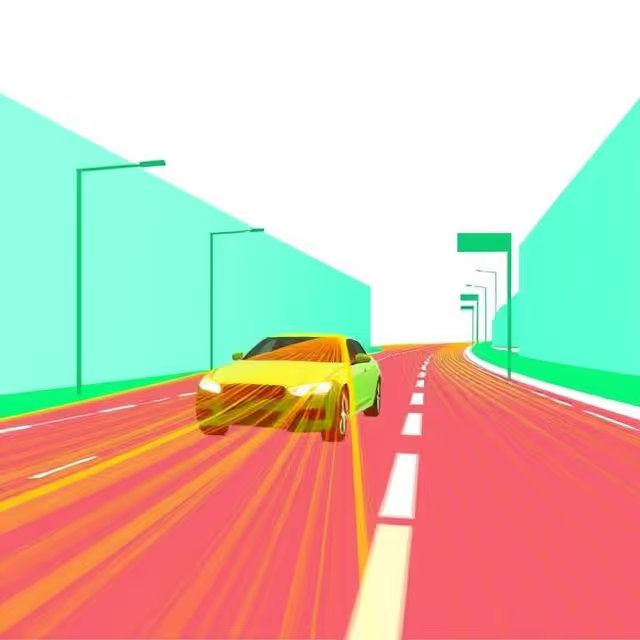Why LiDAR and Sensor Fusion Annotation Matters
Autonomous vehicles (AVs) depend on precise environmental understanding to make safe and effective decisions. This relies heavily on sensor fusion—the integration of data from multiple sources such as cameras, LiDAR (Light Detection and Ranging), radar, GPS, and inertial measurement units (IMUs). Among these, LiDAR provides highly accurate 3D spatial data, acting as the vehicle’s eyes.
But raw LiDAR point clouds or sensor data alone aren't enough. These inputs need to be labeled and structured—a task requiring both computational and human precision. Annotating LiDAR and fused sensor data unlocks the true power of machine learning models in perception, including:
- Obstacle detection 🧱
- Object tracking 🏃♂️
- Drivable area segmentation 🚧
- Depth estimation and range mapping 🎯
- Behavior prediction of dynamic agents 🔮
According to McKinsey, the success of Autonomous Driving hinges on perception accuracy, which begins with annotated data.
Unique Challenges in LiDAR Annotation
Unlike camera data, LiDAR produces 3D point clouds—sparse, unstructured, and often noisy. Each frame may contain hundreds of thousands of points, which represent surfaces around the AV. Here are the main hurdles in annotating this data:
High Dimensionality
LiDAR data is not flat. It's a 3D spatial map that requires specialized tools and trained annotators to interpret distances, elevation, and occlusions.
Occlusion & Sparsity
LiDAR struggles with occluded objects and reflective materials. Pedestrians behind bushes or vehicles beside trucks might only be partially visible, making annotation more complex.
Temporal Consistency
Annotations across sequential LiDAR frames must remain coherent for object tracking and behavior prediction tasks.
Sensor Misalignment
When fusing LiDAR with cameras or radar, calibration drift or timestamp mismatch can cause spatial misalignments, making annotation inconsistent.
Semantic Complexity
Not all objects are equal—annotating cyclists, scooters, and traffic signs in 3D space demands refined semantic taxonomy and spatial awareness.
These challenges are not just technical—they’re practical. Without the right strategies in place, even the most detailed data becomes unreliable for model training.
Mastering LiDAR Annotation Techniques
Let’s now explore how experts approach LiDAR annotation with accuracy and scalability in mind.
1. 3D Bounding Boxes: The Industry Standard
The most common way to annotate objects in LiDAR is through 3D bounding boxes. Each box represents an object’s dimensions, orientation, and class in three-dimensional space.
Key considerations include:
- Yaw rotation: Objects need orientation alignment (e.g., vehicles facing different directions)
- Center point placement: Ensuring the box aligns with the true centroid
- Size variation: Adapting boxes for small (e.g., pedestrians) vs large (e.g., trucks) items
Platforms like Scale AI and Deepen AI offer toolkits to streamline these annotations.
2. Semantic Segmentation in 3D Space
More granular than boxes, semantic segmentation classifies each point in a cloud with a label (e.g., road, sidewalk, pole, tree). It’s essential for:
- Drivable surface detection
- Scene understanding
- Localization and mapping
For instance, Waymo’s open dataset uses extensive segmentation to train its driving stack. This technique often leverages deep learning models for pre-labeling, then uses human correction for refinement.
3. Instance Segmentation for Dynamic Agents
Instance segmentation takes things further—labeling each unique object even within the same class (e.g., 5 pedestrians, not just “pedestrian” in general).
This enables:
- Multi-object tracking (MOT)
- Trajectory forecasting
- Collision avoidance modeling
Annotating this way is time-consuming but invaluable for applications where AVs must interact with multiple moving entities.
4. Temporal Labeling Across Frames
To maintain label continuity across frames, annotators link objects frame-to-frame using consistent IDs. This supports:
- Object permanence understanding
- Predictive behavior modeling
- Multi-frame fusion accuracy
Modern pipelines integrate this with optical flow and ego-motion calculations to maintain accuracy over time.
5. Sensor Fusion Alignment Techniques
Combining camera and LiDAR views creates richer scene understanding—but only when well-aligned. Techniques include:
- Calibration matrices: Precomputed 3D → 2D projections
- Timestamp syncing: Time interpolation for moving platforms
- Auto-alignment AI: Using pre-trained models to reproject data across sensor domains
Some open-source tools like KITTI and nuScenes provide valuable calibration references.
The Role of Human-in-the-Loop Annotation
While automation speeds up annotation, human-in-the-loop (HITL) is key for quality assurance.
Best practices involve:
- Pre-labeling: Use pretrained models to auto-annotate
- Manual review: Trained experts verify or correct
- Active learning: Prioritize labeling uncertain or edge cases
- Consensus modeling: Merge multiple annotations for higher reliability
Annotation platforms with integrated HITL workflows, like Labelbox or SuperAnnotate, significantly improve quality while reducing cost.
Quality Control: Going Beyond Accuracy
AV models trained on noisy annotations are dangerous. That’s why robust Quality Control (QC) protocols are critical.
Top-tier QC includes:
- IoU Metrics: Intersection-over-Union between predicted vs human labels
- Manual spot-checks: Reviewing 10–20% of labeled frames
- Edge case escalation: Routing anomalies to senior reviewers
- Redundant labeling: Multiple annotators label same frames for consensus
Additionally, leveraging annotation dashboards with key metrics (like labeling speed, error types, object-class confusion) can inform both annotator training and project decisions.
Simulation and Synthetic Data: The New Frontier
As the demand for annotated data explodes, simulation and synthetic data are emerging as game-changers in the development of autonomous vehicle (AV) perception systems. Traditional data collection and manual labeling are time-consuming, costly, and sometimes even dangerous—especially when it comes to rare or hazardous driving scenarios. Synthetic data offers a powerful solution by generating photorealistic, fully annotated datasets programmatically.
Why Synthetic Data is Gaining Traction
Synthetic data platforms like Parallel Domain, Cognata, and Deepen AI allow AV teams to create entire virtual cities, weather systems, and traffic behaviors to generate diverse datasets. Every pixel, every LiDAR point, and every radar signal is generated with perfect ground truth annotations, eliminating human labeling errors.
Key benefits include:
- Controlled Environments: Developers can simulate rain, snow, fog, or night driving without risking safety.
- Rare Event Modeling: Easily generate rare or edge-case scenarios like ambulance overtaking, animal crossings, or road debris.
- Data Diversity: Achieve balanced datasets across demographics, vehicle types, road topologies, and urban/rural conditions.
- Cost-Effectiveness: Once built, simulation engines can generate vast datasets with minimal human labor, slashing annotation costs.
- Iterative Testing: Developers can test new models quickly, feeding back synthetic scenarios for retraining and validation.
For example, a pedestrian darting across a multi-lane highway at dusk might be seen once in a million real-world frames. With simulation, it can be replicated hundreds of times under varying conditions, building robustness into perception models.
Blending Synthetic and Real Data
While synthetic data is powerful, it’s not a silver bullet. On its own, it can cause models to overfit to “clean” virtual environments. That’s why hybrid workflows—combining real-world and synthetic datasets—are now the gold standard.
Best practices for synthetic–real integration include:
- Domain adaptation: Use techniques like CycleGAN or Sim2Real transfer to close the visual gap between virtual and real scenes.
- Validation pipelines: Always test on real-world edge cases to detect model hallucination or blind spots.
- Synthetic pretraining + real fine-tuning: Train perception models first on synthetic data, then refine them on real data for generalization.
Even top AV companies like Waymo and Aurora publicly acknowledge the use of simulation pipelines to augment data variety and fill gaps, especially in rare or dangerous scenarios.
Common Pitfalls (and How to Avoid Them)
Despite advances in annotation pipelines and tools, many AV teams still face recurring mistakes that compromise data quality and model performance. Here's a closer look at the most common traps—and how to sidestep them:
1. Annotation Drift Over Time
As teams grow or rotate, labeling inconsistencies creep in. For example, one annotator may label a pickup truck as a “car,” while another classifies it correctly. Over time, this creates noise in your dataset and reduces model confidence.
How to avoid it:
- Establish crystal-clear annotation guidelines and class definitions.
- Regularly audit past annotations for drift and retrain annotators.
- Use automatic label validation tools to flag inconsistencies.
2. Fusion Misalignment
Sensor fusion requires pixel-perfect calibration between modalities. A misaligned LiDAR–camera pair will produce bounding boxes that appear “off” in either view, leading to poor training signals.
How to avoid it:
- Recalibrate sensors frequently, especially after hardware changes.
- Use automated alignment correction methods or SLAM systems.
- Validate fusion outputs manually before pushing to production datasets.
3. Overly Generic Classes
If your taxonomy is too vague (e.g., lumping sedans, buses, and motorcycles into “vehicle”), your model may struggle to differentiate between critical road actors.
How to avoid it:
- Build a hierarchical taxonomy with subclass granularity (e.g., vehicle → sedan, SUV, truck, etc.).
- Ensure sufficient examples of each subclass in training data.
- Use synthetic data to supplement rare subclasses.
4. Ignoring Edge Cases
AVs need to handle uncommon but critical events, like people in wheelchairs, construction signs, or pets running onto the road. These are underrepresented in public datasets.
How to avoid it:
- Curate an edge case library from open datasets, simulations, and internal logs.
- Prioritize manual annotation for these rare events.
- Feed these examples into model retraining and stress tests.
5. Quality Assurance Bottlenecks
Many teams treat quality checks as a one-time process. But annotation is a living pipeline—errors multiply as data scales.
How to avoid it:
- Set up continuous QC workflows with metrics like mIoU, false positives, and label coverage.
- Use reviewer hierarchies (junior > senior > auditor) to catch errors at multiple levels.
- Introduce spot-checking on both old and newly annotated data.
6. Neglecting Temporal Coherence
For tasks like object tracking or motion prediction, inconsistent labeling across frames ruins temporal context. For instance, if a pedestrian’s ID changes mid-sequence, trajectory forecasting becomes unreliable.
How to avoid it:
- Use automated ID tracking based on motion vectors.
- Train annotators to maintain object persistence manually when automation fails.
- Leverage self-supervised learning for tracking stability over time.
Annotation Use Cases Across the AV Stack
Annotations aren’t just for perception. They ripple through the entire AV stack:
- Localization & Mapping: SLAM systems require labeled landmarks for environmental awareness
- Planning & Control: Understanding pedestrian intent impacts how the AV responds
- Behavior Prediction: Annotated trajectories and agent motion histories feed into predictive AI modules
- Regulatory Validation: High-quality annotation supports auditability and safety standards (e.g., ISO 26262)
By investing in annotation quality early, AV companies reduce costly edge case failures later.
What’s Next: The Future of LiDAR and Fusion Annotation
The annotation landscape is evolving. Expect to see:
- Self-supervised learning: Reducing need for manual labels
- Foundation models for point clouds: Similar to GPT or CLIP, but for 3D
- Multimodal AI: Combining vision, language, and LiDAR for richer scene understanding
- Real-time labeling: On-device annotation to support continual learning
- Federated annotation: Secure, distributed labeling across global teams
As the autonomous ecosystem matures, so will the expectations around annotated data—not just in volume, but in value per label.
Let’s Get You Ready for What’s Next 🚀
Whether you’re building the next-generation AV tech stack, designing datasets, or evaluating AI vendors, understanding how LiDAR and sensor fusion annotation works is non-negotiable.
👉 Want help with high-quality AV data annotation or edge-case simulation?
At DataVLab, we specialize in advanced labeling workflows for LiDAR, video, and multimodal data—trusted by startups and enterprise teams alike.
Let’s turn your data into safer driving decisions.
Get in touch with our expert team and future-proof your perception stack today.





